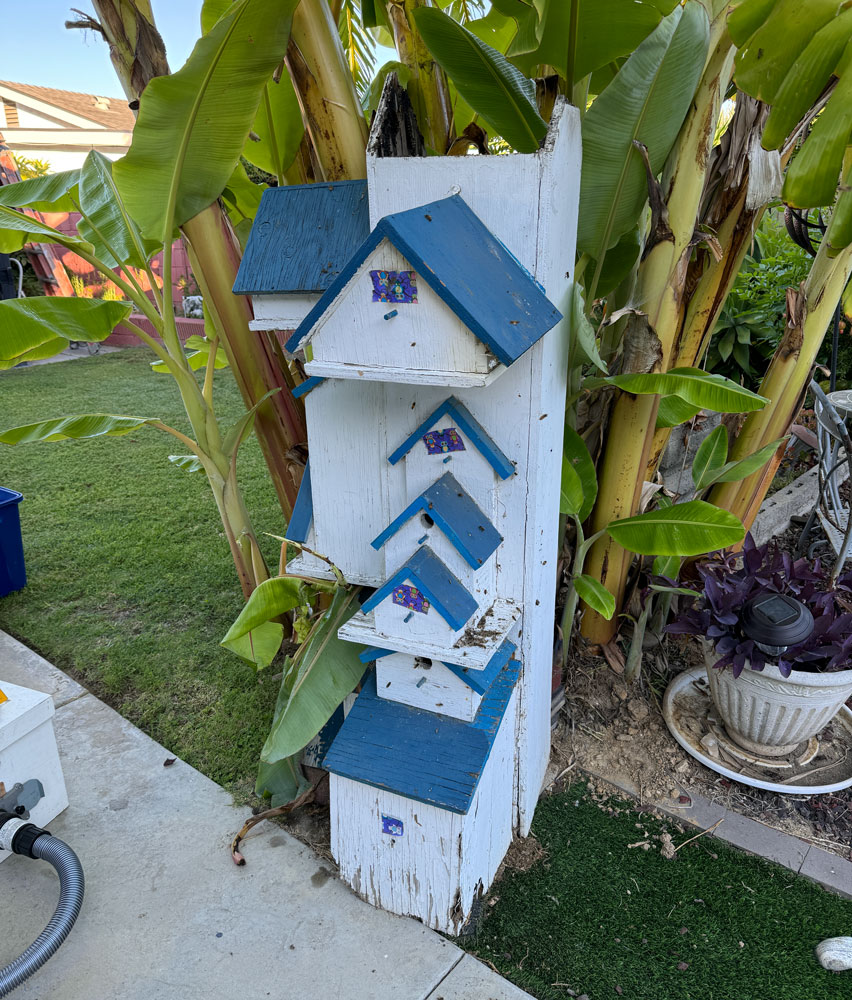
A Beehive for JT
August 20, 2024
P. Michael Henderson
My friend, JT, had bees in one of his bird boxes. The bees were very docile but had completely filled the bird box and had started making comb on the outside of the box. I convinced him that we should transfer the bees to a regular hive and we did that on Thursday, August 15th.
Everything went normally and we moved the bees and their brood into a standard hive. However, by Saturday, ants had gotten into the hive and were so bad that the bees absconded. We both felt bad - we should have known that ants were a possibility and taken steps to prevent them from getting into the hive.
But you have to move on, so I put a notice on NextDoor and a woman, Carol, contacted me about bees that she had in a bird box in her yard. JT and I went there this morning, Tuesday, August 20th.
Here's the birdhouse. The bees were in the bird box at the top of the structure. Note that Carol had tried to get rid of the bees by putting tape over the bird box entrance, but the bees found another way in.

I pried one side of the roof off and this is what I found. A box completely full of bees and brood comb. One piece of brood comb came up with the roof section. The rest stayed in the box.

I went to work vacuuming the bees into the bee vacuum. In this picture, I've removed the one piece of brood comb and a small piece of honey comb. The bees were very docile. They did not come at us - just clustered on the comb and the outside of the box. When you open an aggressive hive, especially when you start removing brood comb, the bees really attack you to defend their hive. This hive was definitely not aggressive.
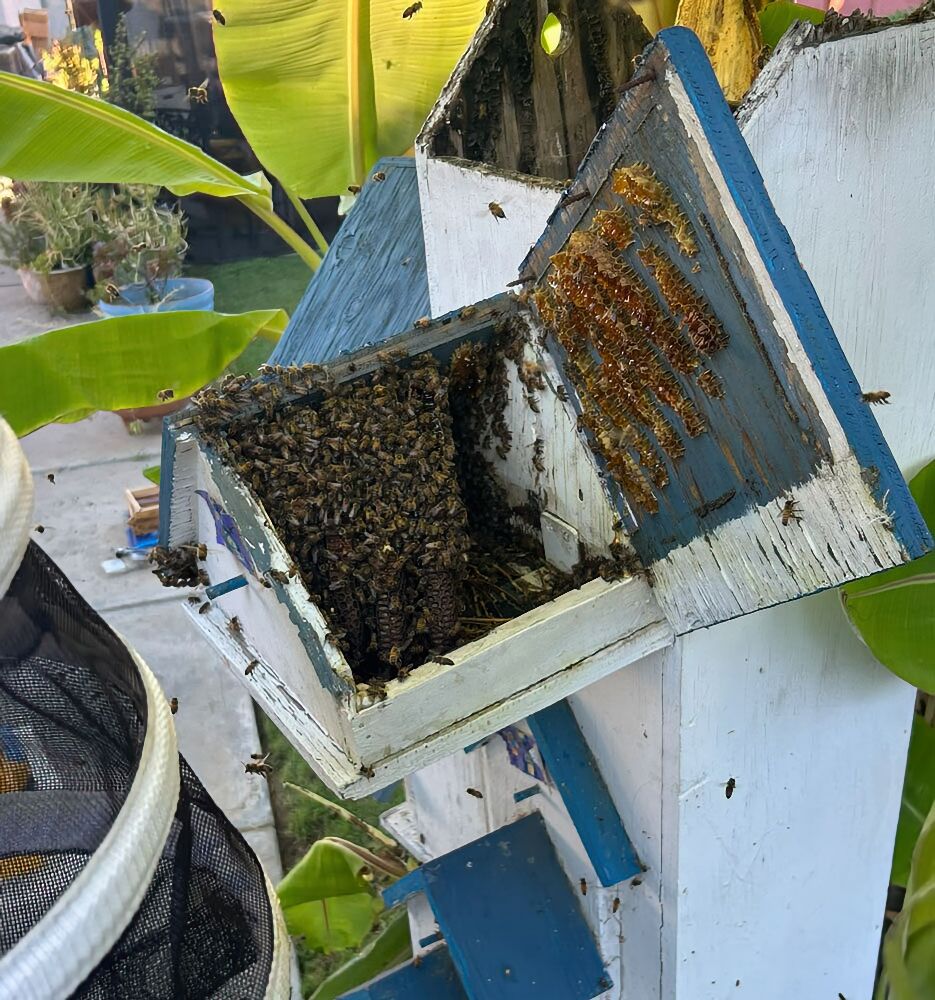
JT took pictures of me working the hive. There are bees on my back because I'm standing in the flight path of the returning foragers. JT just vacuumed them off of me.
Although you can't really see what I'm doing here, I have a piece of comb in my hand and I'm vacuuming the bees off of it.

Here I have a piece of comb that's mostly honey. I've vacuumed the bees off of it.

After I processed all of the comb, there were still bees in the box and I tried to vacuum as many as I could.
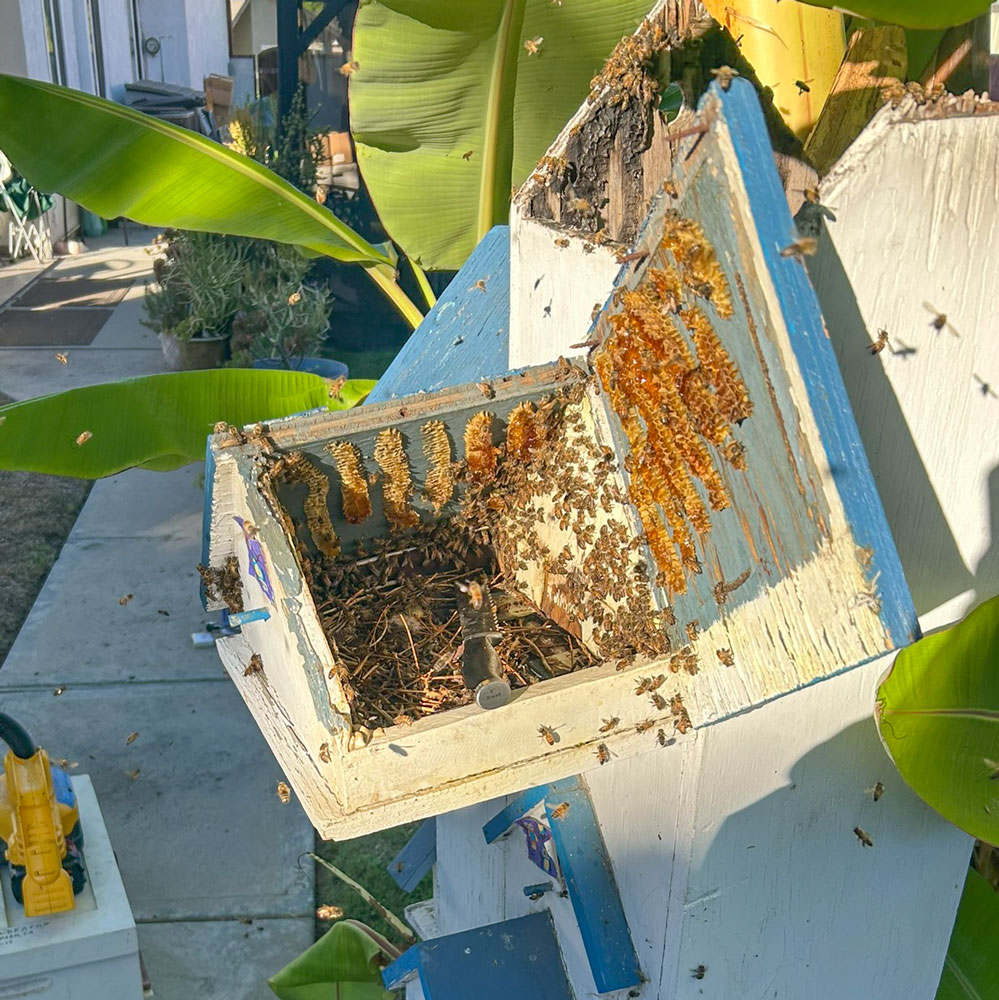
When we had gotten as many bees as we could, we packed up and headed back to JT's place, where we took the brood comb and put it in standard frames. We filled two and a half frames with the brood comb.
I put those frames in the center of the hive box and then put the bee vacuum on top of the hive, allowing the bees to move down into the hive.
Here's a picture of JT and the hive with the bee vacuum on it. He has some ant traps under the hive. They have oil in them which prevents the ants from getting into the hive. The blocks of wood under the ant traps at the rear of the hive is to orient the hive with a slight forward slant to keep water out of the bottom of the hive when it rains.
JT found these "ant traps" on Amazon. They seem to work well, but are a bit unsteady. See the entry below for what I did to improve them.
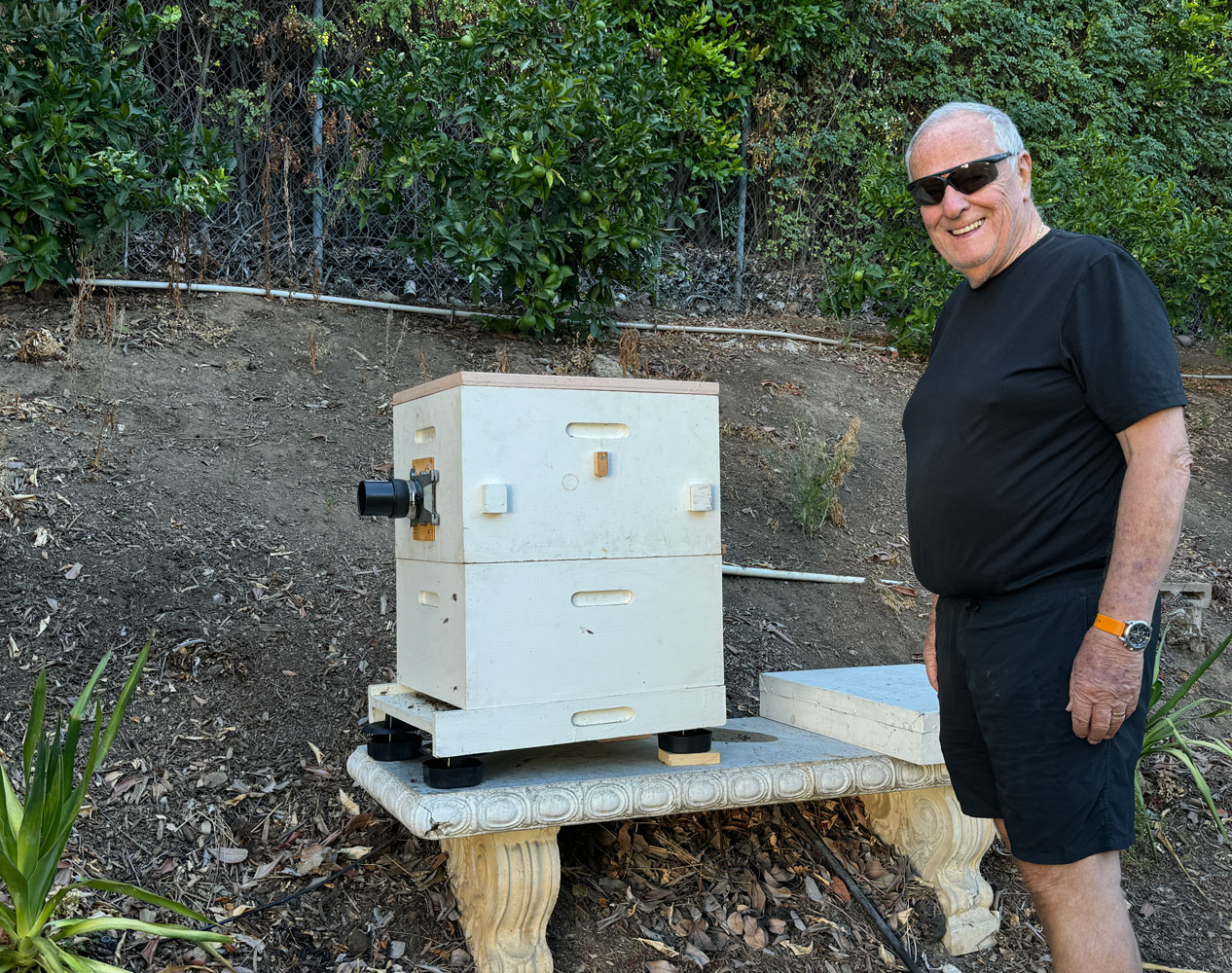
The next day we went back and removed the bee vacuum from the hive. The bees were clustered on the brood comb, which is normal for them. We fed them some honey by pouring it on the top of some of the empty frames. The bees are docile and didn't pay any attention to us as we removed the bee vacuum.
It's hard to see, but here's a view into the hive. The bees are clustered on the brood comb we put into the hive.
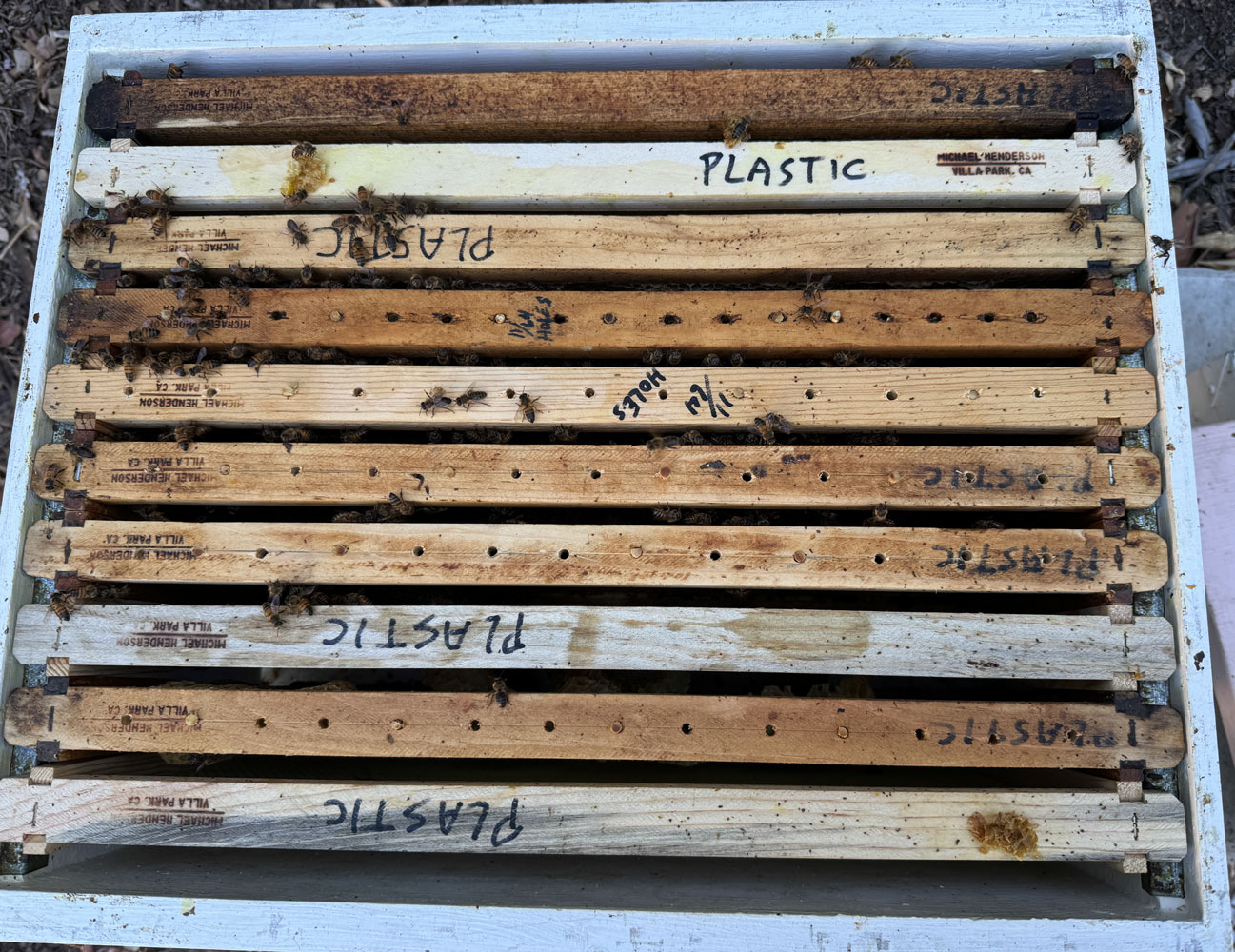
Finally, here's a picture of the hive without the bee vacuum. If we got the queen, they will eventually fill up this one brood box and we'll add another brood box, an excluder, and a couple of honey supers.
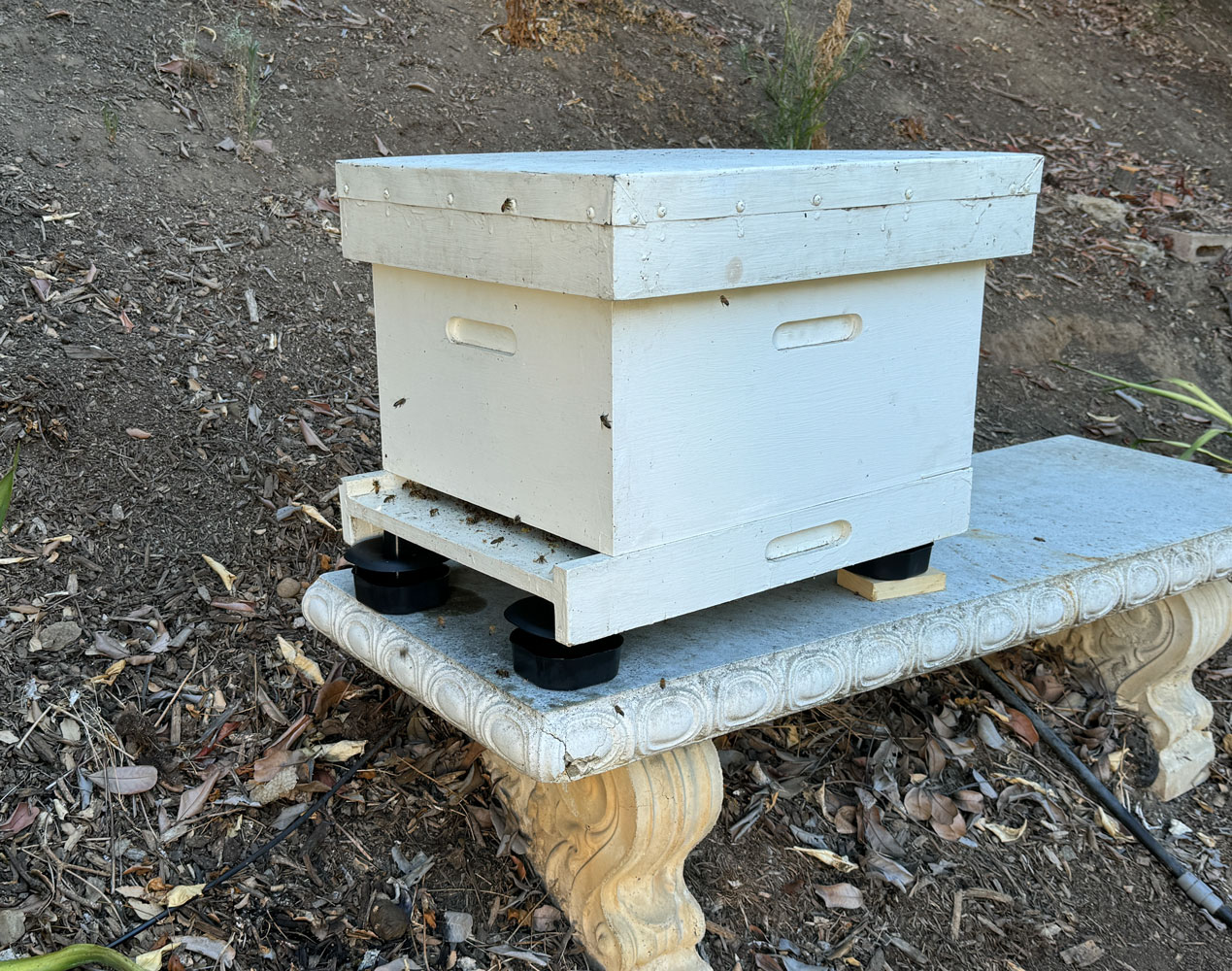
I'll go back into the hive in a couple of weeks to see if there's fresh brood. If so, it will indicate that there's a queen in the hive. I have my fingers crossed.
++++++++++++++++++++++++++++++++++++++++++++++++++++++++++++
Monday, 8/26/2024 I went out to check the mail and saw a bee rescue truck at my neighbor's house. I went over and talked to my neighbor and he told me he had a swarm high in a tree in his yard. I don't climb ladders at my age so I just went and watched the beekeeper retrieve the hive.
I talked with the beekeeper afterwards and showed him my bee vacuum. He offered the bees to me. I didn't need them but accepted them for my friend JT. I put the bees into the bee vacuum and took them to JT's and put them on top of the hive. By the next day, the bees had moved down into the hive. If there was a queen in the hive, the two queens will have to decide which one will survive.
+++++++++++++++++++++++++++++++++++++++++++++++++++++++++++
Saturday, 8/31,2024 I went over to check on the bees and they had absconded. Seems that the new queen didn't like the hive box and I (foolishly) did not put an excluder at the bottom of the brood box to make sure she couldn't get out.
+++++++++++++++++++++++++++++++++++++++++++++++++++++++++++++++++
Sunday, 9/1/2024 I got a call from a homeowner who had a swarm in a tree in their backyard so Greg and I went an picked up the bees and put them in the hive at JT's place. This time I put an excluder below the brood box.
+++++++++++++++++++++++++++++++++++++++++++++++++++++++++++++++++
Saturday, 9/7/2024 I received a call from a homeowner who had a swarm clustered under the eve of their house, so JT and I went an picked it up and put it on top of the swarm of 9/1/2024. The bees had been there for several days and had started making comb. Apparently they couldn't find a cavity to move into.
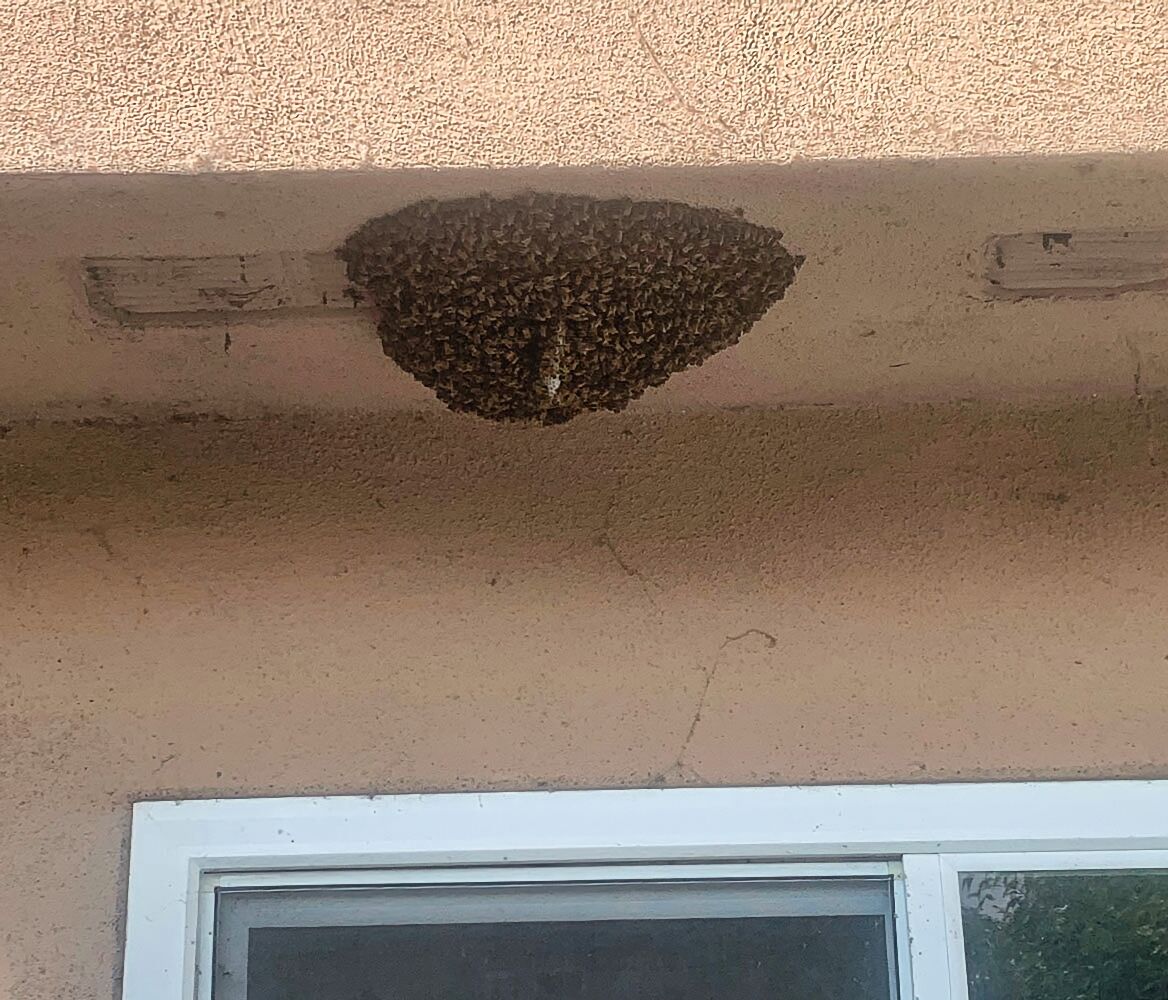
We put these bees on top of the bees which were already in JT's hive.
I'll go into the hive in two weeks and see if there's any brood.
This has been an adventure - this is the fifth batch of bees that I've put into the hive. We lost too many of them due to bad decisions (ants, and no excluder).
++++++++++++++++++++++++++++++++++++++++++++++++++++++++++++++
Wednesday, 9/18/2024 JT and I went into the hive today to check for brood - and we found capped brood and larva. So the queen is present and laying. The bees have a long way to go to build up their population but they're on their way. Our winters are not too tough so the bees may be able to build up their population even through the winter. Certainly in the Spring they will have the nectar and pollen to increase their population. We might even see some surplus honey by the fall.
The bees are quite docile so far.
++++++++++++++++++++++++++++++++++++++++++++++++++++++++++++++
Friday, 9/27/2024 JT reported that a coyote had knocked the supports out from the front of the hive, apparently to get to the cooking oil that was in the supports. This had stirred up the bees.
I decided to make a stand that would be more stable than just the four plastic "ant traps/hive supports". Here's what one of the ant traps looks like. Note the plastic "shield" that protects the container from water and trash intrusion. The shield fits on the square (but tapered) shaft in the center of the unit. I did not use the shields for what I did.

I took a piece of plywood, 22 inches by 16 1/4 inches, and put four of these "stands" under it.
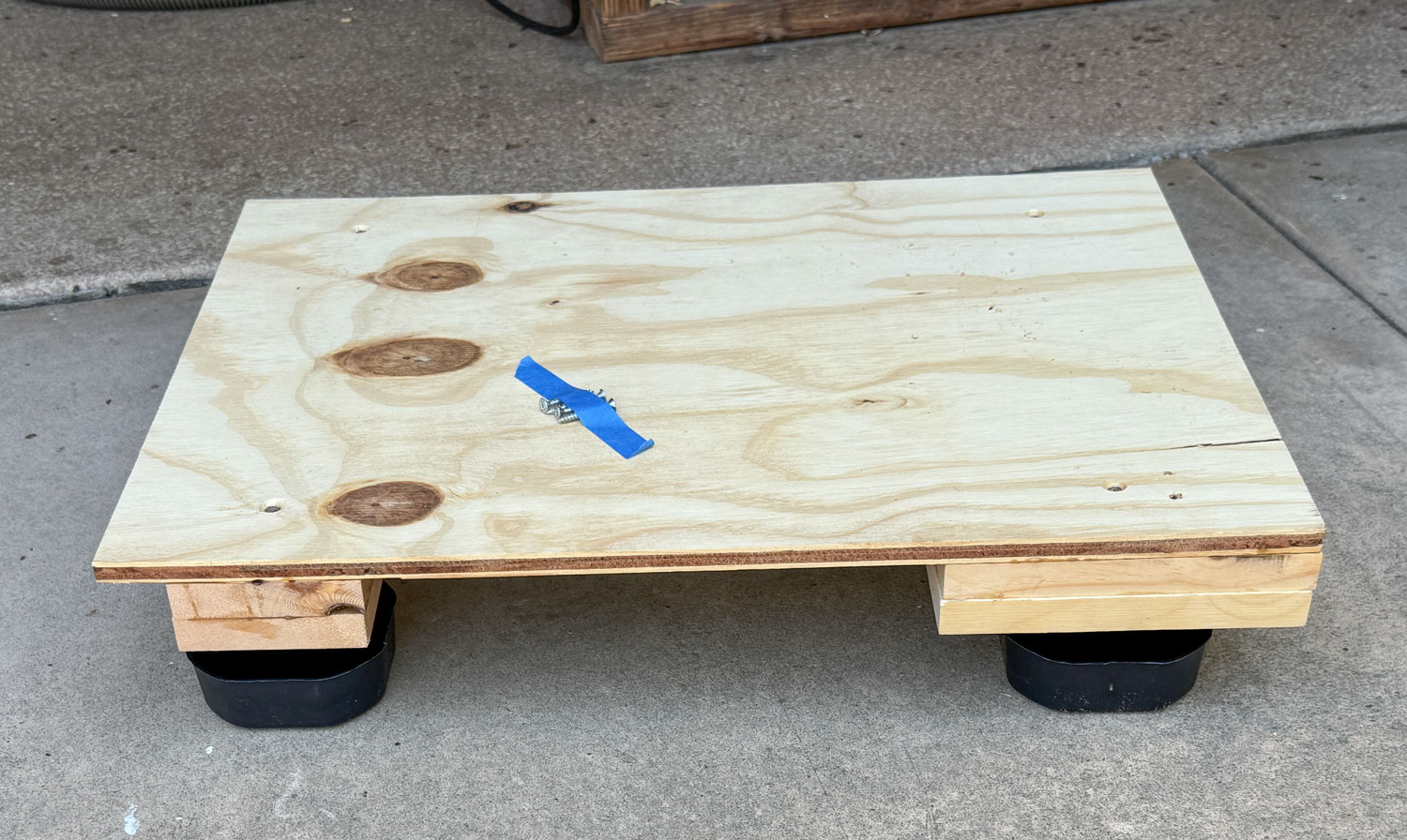
To hold the stands in place, and to provide support to them, I put a block about 1.5 inches high towards each corner. I had drilled out the center of the block with a 1 1/4 inch Forstner bit and then squared and tapered the hole to fit the stands. Then glued it to the plywood.

Here's one of the stands in a block. I didn't use the shields because the plywood will shield the cups.
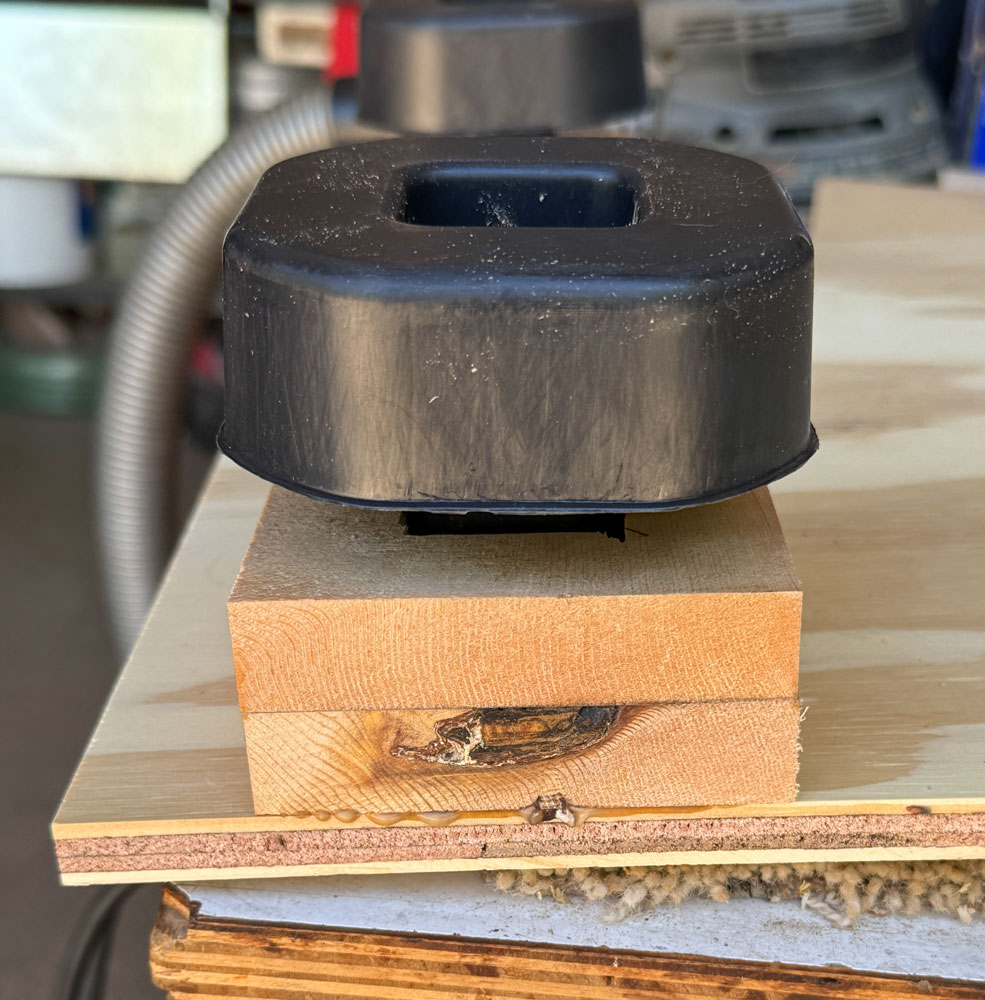
And here's the hive stand, upside down to show the location of the four ant traps/hive stands.

Here's a repeat of the stand upright. Note that there's a hole drilled above each stand. Once JT fills the cups with oil (probably motor oil this time) he will put a screw in the hole to keep the ant traps/hive stands in place. They're a friction fit right now, but when the cups are filled with oil, they will be heavy enough to fall out without the screw.

I'll report back after we switch the hive over. We'll do it by putting this stand next to the hive. Then we'll each take one end of the hive, pick up the hive, and sit it on the stand. Remove the old ant traps, and then pick up the hive and stand and set it back in place.
++++++++++++++++++++++++++++++++++++++++++++++++++++++++++++++
Monday, 9/30/2024 I went over to JT's place about 9am and we moved the beehive to the stand I had made (see above). The bench that the hive sits on slants downward at the back of the hive so I put a piece of wood on the back of the stand to tilt the hive forward (so that rain does not come into the hive). Here's a picture.

We were careful to not jar the hive while moving it and the bees barely noticed what we were doing.
To add the extra brood box and super, I did not smoke them first and they were fine. I did smoke them a bit to drive them down into the hive so that when we put the second brood box on we wouldn't crush any of them.
The frames in the second brood box and the super only had foundation - no drawn comb. So it will take time for the bees to make enough wax to draw out comb on those frames. I read somewhere that bees require 8 pounds of honey to make one pound of wax. It's going to be a while before we can harvest any honey from this hive.
The bees were quite docile - maybe two of them came around my veil and when we walked away, they didn't follow us. All good signs.
The real test of aggression will come when they have built up their population and have some resources in the hive but I'm optimistic at this point.
+++++++++++++++++++++++++++++++++++++++++++++++
Wednesday, 12/18/2024 - It was a warm day today so JT and I decided to take a look into the hive. There was nothing going on in the super, and not much in the upper brood box. But in the lower brood box the bees had about six frames with brood and honey. I removed a few frames just to check on them and JT took a picture of one of the frames. Even though it's December, they have some brood on the frames and a good amount of honey around the brood area. If you look closely, you can see some capped brood and some larva on the frame. I didn't try to find the queen - seeing the brood was enough to know she is there.
That's capped honey along the top of the frame.
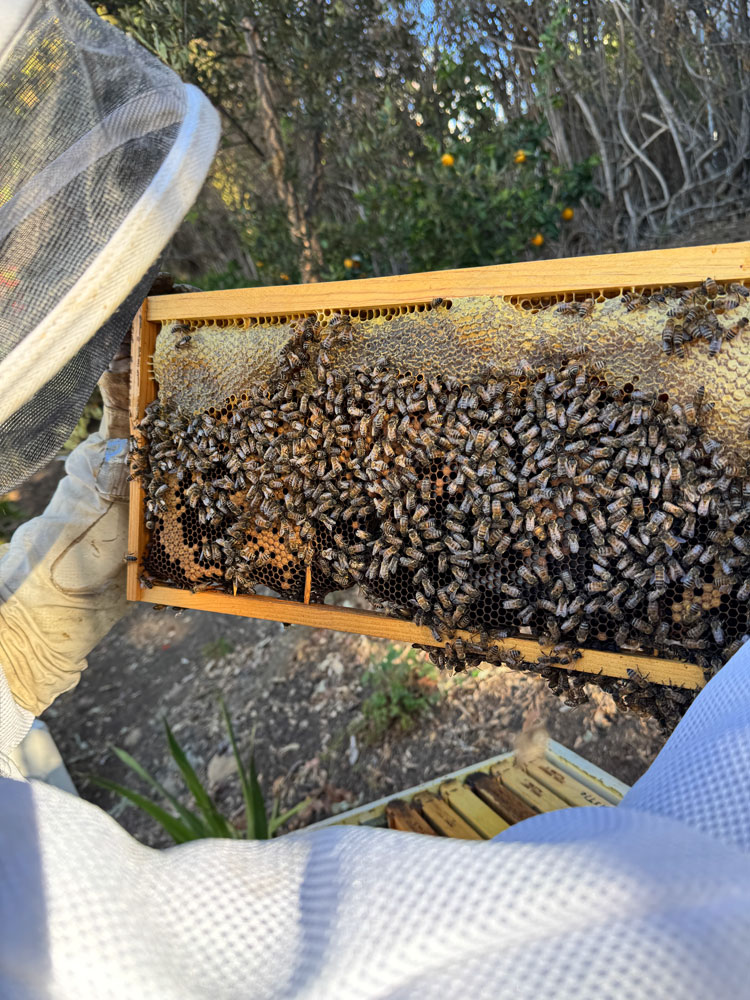
And the bees were VERY docile. They just stayed on the frames - none of them came towards us. I wanted to take pictures with my iPhone so I had my right hand bare while I was working with them - I can't work the iPhone very well with gloves on - and the bees didn't bother me. Of course, Africanized bees tend to become more defensive once they fill up two brood boxes, so we'll have to see what they're like in late spring or early fall. This hive only had a small amount of drawn comb that we took from the first cutout described on this page so they'll have to draw out comb on all the other frames. That's very resource intensive (takes a lot of nectar to make comb) so it'll be a while before they have much harvestable honey.
All-in-all, a very nice hive, making good progress.
They're so docile that I'm a bit worried they might be a swarm from a European hive (a few people keep European bees but I don't know of any in this area). That would be a problem because of varroa.
+++++++++++++++++++++++++++++++++++++++++++++++
Tuesday, 4/7/2025 - The news is not good. JT noticed a swarm in a tree at his place. We picked it up, but then another swarm appeared the next day. Then a third. It's obvious that his primary hive is throwing off swarms, which is an Africanized trait. We went into his primary hive and the bees were agressive. We'll have to kill the hive.
I suggested that we wait until we get a call for a swarm or cutout in our area and we pick up the bees. Then we kill his hive with soapy water, wash the frames, and put the swarm/cutout in that hive box. We're waiting for a swarm/cutout call now.
Click here to go back to my main page.